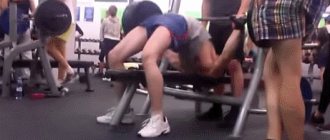The effect of breaks in sports on the body
In order to create a program for restoring muscle mass and returning muscles to tone, you need to know exactly how a break in sports affects your body. The consequences of interruptions will vary depending on their duration.
A week
If the break between the last and next workout is a week, nothing bad will happen to the muscles. They begin to lose their strength, elasticity and shape only ten days after stopping sports. Over the course of a week, muscle tissue gradually recovers from damage, especially if the training was particularly intense, so a week-long break may even be beneficial. The main thing is not to delay returning to training, since with each subsequent day it will be more and more difficult to get back into shape. Therefore, you can safely go on vacation without worrying about your appearance and shape. In some cases, after such a break, there is even a rise in strength and a surge of energy, so necessary for training.
Month
If the break between workouts lasts a month, the physical capabilities of the muscles begin to decline. The body weakens, fully recovered muscles stop regenerating and, therefore, their growth stops. This leads to a decrease in muscle strength and a decrease in their volume. In addition, endurance deteriorates due to a decrease in the amount of glycogen in the muscles during periods of non-exertion. But despite this, it is possible to get back in shape after a month-long break by putting in a little effort and properly planning your workout, including basic exercises that involve the maximum number of muscles.
A few months
A break of several months or more is fraught with loss of muscle memory, which is responsible for rapid muscle recovery. These changes occur at the nervous system level, changing and weakening muscle coordination. You can recover quickly after such a long break only if your sports experience is long enough, and most of the movements and exercises have been practiced to the point of automatism. This is called a motor skill that stays with us almost for the rest of our lives, and you don’t have to re-accustom your muscles to loads.
A year or more
After a year-long break from sports, the body returns to its original shape, which you had before you started regular physical activity. If you do not resume training, then no further changes occur in the muscles; they no longer recover and grow, stabilizing in the form necessary to perform basic motor functions used in everyday life. In order to regain your lost shape, you will need to start all over again, starting classes from the initial level.
Where to start training?
You could say I started everything from the very beginning. Since I have practically no experience in creating programs, I took the training program for beginners from Dmitry Golovinsky as a basis. In his program, I replaced the standing press with a seated press. Yes, in this case fewer muscles will be involved, but this way I don’t experience discomfort in my back.
When preparing a training program for myself, I reduced the weight in all exercises. The first week of training was more like a warm-up than a full-fledged workout. But every week I gained 2.5-5 kg depending on the exercise. My recovery training program looks like this:
The best workouts for the first day after a long break
HeungSoon/Pixabay
If you're ready, it's time to start training. We've handpicked six workouts that are perfect for your first (or second) day of training after a long break.
1. Body exercises
Do this 15-minute workout that requires zero equipment. Too easy? Add more sets and less rest time between exercises to get more benefits from your workout.
2. Free weights
Try training with free weights. It's just deadlifts, squats, overhead presses and biceps curls. Lighten the weight than usual since it's your first day so you won't be sore later.
3. Gym
For the first days of training, and even then, cardio equipment is better suited. They will help you build up your endurance and prepare you for more work later. If you don't know which gym equipment to choose, here's a guide to cardio equipment.
4. Running or cycling
Parks and squares in the spring will be full of running people who are trying to lose weight or stay in shape. Running is good for your health as well as your body. If you haven't exercised for a long time, running is the best thing you can do to start your new fitness journey. Before you start running, you just need to know how to run correctly to avoid injuries.
In addition, cycling will be useful. Try to go for a walk every day, at least for a little while. If possible, ride your bike to work. This is an ideal option to get used to heavy loads.
5. Zumba
There is nothing more fun than Zimba, which entertains and tightens your body in dance. There is nothing stopping you from setting aside 5 to 10 minutes for your workout. Over time, these mini-workouts turn into something more. You will have a desire to do more exercises and spend more time training. So be sure to check out the 7-Minute Zumba Workout.
6. Yoga
This Yoga Basics workout with Kino MacGregor is designed for beginners, so it's a great way to get started or learn the basics of yoga. This is a short video of 12 minutes, so if you want more, then add some more yoga asanas for beginners that help you lose weight.
2-3 weeks have passed since the last training.
Probable reason: you were sick.
You think: “No time has passed! I can work out just as intensely.”
In fact: “An illness, be it bronchitis, flu or minor poisoning, for which many of us won’t even go to the doctor, is intoxication of the body, loss of fluid, disruption of water-salt metabolism. The blood thickens and flows more slowly, providing the muscles with less oxygen and nutrients. We don’t feel like eating, we forget to eat before class, and as a result, the usual jogging or aerobics lesson is much more difficult,” says Irina Guseva, sports doctor, fitness testing instructor at the Republika fitness club
There is one more point. In the first four hours after training, immunity is reduced. We went out into the street, steaming, got caught in the rain, drank cold water and... caught a cold again.
How to act: after illness, give up fitness for a couple of weeks - it’s not for nothing that the school is exempt from physical education lessons for this period. And at this time, eat fruit more often, drink freshly squeezed juices and homemade fruit drinks, as well as mineral water to normalize water-salt metabolism.
It is worth returning to exercise only after you have fully recovered: a runny nose will not allow you to breathe properly, and a cough may intensify in response to cardio and even strength training - for example, during abdominal exercises, during which the diaphragm works. For the first two weeks, exclude high-intensity workouts from your fitness schedule: step, tai-bo, cycling. Don't go to the sauna: your heart rate will jump. Watch yourself carefully. If your pulse jumps sharply even with a slight load and recovers too slowly when you rest, if you feel dizzy during exercise, and after it you feel not just tired, but overwhelmed, perhaps you have not completed your treatment or the disease has caused complications, which are mentioned you don't suspect.
The harm and benefits of breaks in sports
As you already understand, the effect of breaks in sports on the body directly depends on their duration. However, they can have both negative and positive effects on muscle condition. Let's start with the benefits of breaks in sports. Let's talk about breaks that are within acceptable limits, namely those that last no more than a month. During this period, your muscles will have time to fully recover, your body will gain new strength and energy, thanks to which you will be able to begin physical activity again. In addition, a break from sports can be an excellent reason to change physical activity and try a new sport.
Now let's talk about the dangers of breaks in sports. As mentioned earlier, one of the most significant problems associated with stopping training is a decrease in muscle mass. If your goal is a beautiful, sculpted and toned body, then a break can lead to a complete loss of existing results and force you to start all over again, reducing all previously made efforts to nothing. Another danger of long breaks in sports is weight gain. The fact is that instead of muscle tissue, which is rapidly decreasing, fatty tissue will appear, which negatively affects the condition of the figure. To prevent this, even in the absence of regular exercise, you must continue to monitor your diet, eating exclusively healthy and low-calorie foods.
Don't be like others
Don't be discouraged if your friend can do more push-ups than you. Or if your personal trainer has abs that you can only dream about.
“Their fitness journey is different than yours,” reminds Aguiar. “When we exercise, we are asking our bodies to adapt, and if Darwin taught us anything, it is that the process of biological adaptation takes time.” Don't let others influence your self-esteem and self-esteem. Focus on your goals and opportunities. Continue to get closer to your goal step by step, and just enjoy the process, she adds.
How to get back to training
When talking about significant mistakes, I mean pointless and dangerous runs of 2-3 km or lifting barbells with “indecent” weights on the first day of training. People try to make excuses and say to themselves: “I used to do these exercises, why can’t I do it now?” The same loads after 5-10 years of inactivity? Do not make me laugh. The easiest and safest way to get back to training is to start with the simplest thing.
Basic training for beginners
The workouts and exercises described below can help both beginners and those who have had a significant break in sports get started. Depending on your physical fitness, the time to enter a normal training cycle can vary from 1 week to 1 month. In this case, we will look at the training using the example of two weeks. Beginners (remembering) can conduct training both in the gym and at home (outdoors).
Week #1
The first week involves light cardio and muscle stretching exercises. Aerobic exercise should be limited to light walking (not running) or low-impact cycling. Stretching should be done at least twice during the day for 20 minutes. Stretching should be done after warming up (for example, walking in place). Do stretches for all muscle groups (legs, arms, back, chest, lower back, abs, neck). Let your heart and muscles gradually get used to the loads, even such light ones.
Week #2
If you choose aerobic training, then the best way to get your muscles used to the load is intervals, i.e. fast walking alternating with slow walking. Increase and decrease the speed gradually over the course of a week.
If strength training is your calling, then use your own weight or light dumbbells before starting with heavy weights. With your own weight you can perform pull-ups, push-ups, crunches, squats, and bends. If desired, you can use isolation exercises for biceps and triceps using light dumbbells (3 sets of 15-20 repetitions). Perform no more than 2 exercises (8-10 repetitions) per day per muscle group (2 sets of push-ups, 2 sets of squats, etc.).
About water
It is very important not to forget about water. This is an excellent way to compensate for the loss of water, because the first workouts require a lot of energy from the body, including water.
In addition, water helps burn calories by speeding up your metabolism. Depending on your weight, you need about 2-3 liters of water per day.
As you can see, nothing complicated. Just let your body adapt to the stress before starting more challenging workouts.
Aerobic training
The best triceps exercises
Superset training
The best leg exercises
Muscle growth and development
How to train your abs
Better less than too much
When you return to strength training, resist the temptation to go all out. Instead, do slightly fewer reps than usual, at least in your first workouts. “It usually helps keep it fresh,” Callaway says. “After such training, the muscles don’t hurt as much, you recover faster and confidently stick to your plan.”
If you normally do 12 reps per set, stop at 9 or 10 and see how you feel the next day. If you recover quickly and realize that you are ready to add, return to the usual number of repetitions in the next workout. Just remember to stop at this point one or two reps before failure, regardless of your skill level.
Several years have passed since the last training.
Probable reason: at some point you simply quit fitness.
You think: I’m still not a beginner and I can train according to my old program.
In fact: during the time during which you fell out of fitness, both you and he changed. A program designed for a healthy athletic student will not suit an overweight system administrator with chronic bronchitis and osteochondrosis. “When you return years later to that fitness club where you used to go, you are unlikely to find the same programs in its schedule, the same old “machines” in the gym, and the same equipment in the stores with which you once performed exercises.”
How to act: forget that you once practiced. The body will remember something on its own: muscle memory will help you perform once mastered exercises without errors (or almost without them), after many years you can ride a bike, roller skate, dance again... After a long break, it’s a good idea to start with something familiar. Take fitness tests (you can do them at home) and choose the optimal load level for yourself.
Principles of healthy lifestyle recovery
- Set up your daily routine: nutrition, training, rest and work. Start your morning with a glass of water, and 10-15 minutes later - a hearty breakfast. Stay hydrated throughout the day. Eat at least six small meals a day, try to include more fiber, vegetables, and low-fat steamed foods in your diet.
- Avoid extremes. Do not make sudden changes in nutrition, training and daily routine. If you constantly overeat, then do not suddenly switch to a series of fasting days. So there is a risk of breaking down. In training, adhere to the same principle - everything should be in moderation. Start by creating a simplified version of the training program for the first week of adaptation. This way you will help the body gradually enter the training process. The length of your break from classes plays a big role in drawing up your plan.
- Start thinking positively to improve your psychological background.
After a long rest from physical activity, muscles, joints and ligaments lose their usual trained tone. Therefore, the first workout after a break is a lot of stress for the body. This means you need to thoroughly prepare for it.
Recovery time
This process develops differently for each person and depends on many factors. But in general, if you haven’t trained for 2-3 weeks (you were on vacation, a business trip, on holidays), you can return to your previous physical shape with two light workouts for all muscle groups.
If you have given up fitness for six months or more, you will have to work longer: 1-2 months (six months of inactivity) and about six months (in the case of a year of inactivity). The working weights when you resume training will be several times less.
If you still haven’t regained shape after two months of training, then you should adjust your program or change your coach.
In many ways, the recovery training program is similar to the training of “beginners”.
Secret of success
For many people, it is very difficult to continue something after a single failure. A mistake demoralizes them and brings a lot of negativity. If this happens to you, try to change your attitude towards the problem so as not to lose motivation.
If you didn't go to the fitness club on Monday, it doesn't mean that the whole week is lost. It just means you have to go there on Tuesday. Or even just walk the dog longer than usual.
The ability to play sports is not only the ability to squat correctly and a bunch of protein on the shelf. This is knowing how to set yourself up for classes and stick to this mood.
Start thinking of yourself as a sports person . And there, you see, it’s not far from the barbell.











